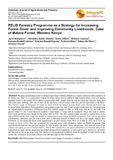| dc.contributor.author | Humphrey, Agevi | |
| dc.contributor.author | Adamba, Mwendwa Kaleb | |
| dc.contributor.author | Koros, Hillary | |
| dc.contributor.author | Mulinya, Carolyne | |
| dc.contributor.author | Kawawa, Rashid | |
| dc.date.accessioned | 2018-03-12T10:58:37Z | |
| dc.date.available | 2018-03-12T10:58:37Z | |
| dc.date.issued | 2016 | |
| dc.identifier.uri | http://r-library.mmust.ac.ke/123456789/509 | |
| dc.description.abstract | Plantation Establishment and Livelihood Improvement Scheme (PELIS) is a scheme introduced after enactment of
the Forest Act, 2005. It is a governance scheme by Kenya Forest Service (KFS) to help increase forest cover and restore
degraded forests in the country. Forest adjacent communities (FAC) benefit from the scheme where they allocated plots upon
which they plant seedlings, take care of them till the area form a closed canopy while they practise agriculture on the farms.
This research sought to determine the extent to which PELIS has helped increase forest cover through plantations and
decreased forest dependency. Both quantitative and qualitative data was used. It also sought to determine how the programme
has helped improve community livelihoods.Cloud-free satellite images of 2001 to 2016 were selected for the study. The
spectral bands 1–5 and 7 were chosen for Landsat 7 while bands 2–7 were used for Landsat 8. These were used to analyse
forest cover and forest cover change for the period 2001 to 2016. The 2001 satellite image was used to analyse forest cover
before PELIS and the 2016 image was utilized to analyse forest cover during the PELIS programme. Open and closed ended
questionnaires, interviews and discussions were used to determine benefits of PELIS and how it has helped improve their
livelihoods. It was found that forest cover experienced a positive increase from 366.9 ha in 2001 to 481.4 ha in 2016, an
increase of 114ha (51%). This was occasioned by increased areas under plantations under the PELIS programme. The
respondents admitted that they get food produce for their families like maize, beans, and potatoes. They also sell some of the
produce and realize income of between Kshs.5, 000-15,000 annually from the parcel of land they are allocated. 90% of the
respondents did agree that the programme has helped decrease forest dependency as most used to go to the forest to get timber
and firewood to sell to get some cash. The success of this programme in Malava could be emulated in other forests in the
country that will lead to an increase in forest cover and help improve their livelihoods. | en_US |
| dc.publisher | American Journal of Agriculture and Forestry | en_US |
| dc.subject | PELIS Programme, Forest Cover, Forest Cover Change, Community Livelihoods | en_US |
| dc.title | PELIS Forestry Programme as a Strategy for Increasing Forest Cover and Improving Community Livelihoods: Case of Malava Forest, Western Kenya | en_US |

